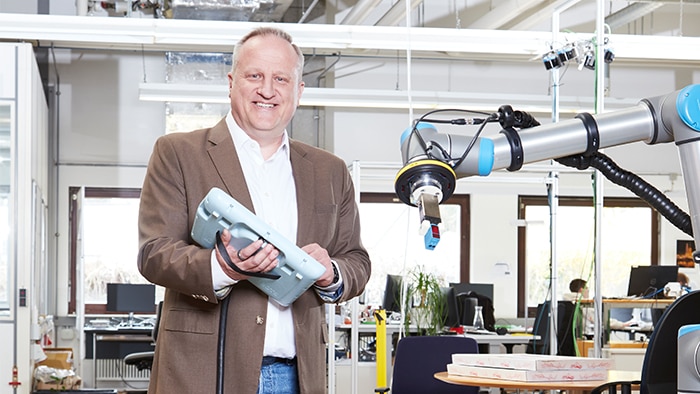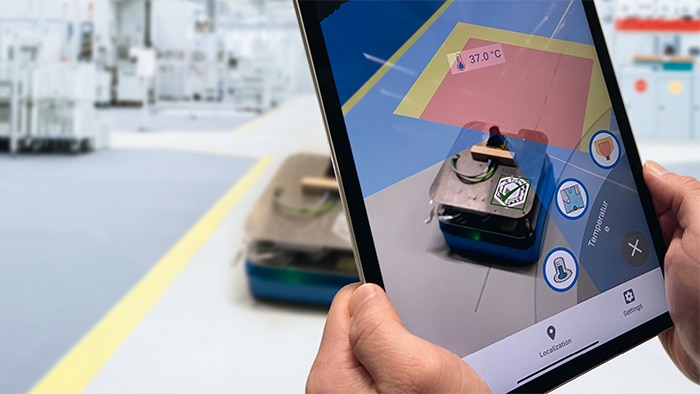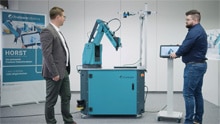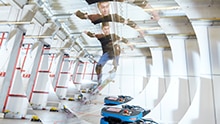There is a paradigm shift currently under way at SICK in the field of sensor and system solutions for using robots safely and efficiently. Volker Glöckle, Senior Vice President of Integrated Automation, explains the dynamic natura of the market and SICK’s transformation into a solution provider.
Productivity and safety in harmony: Interview about integrated sensor solutions for robotics
Mr. Glöckle, your Integrated Automation department has been charged with establishing SICK as a provider of solutions for automation applications. How are you going about?
Fortunately, we’re not starting entirely from scratch. SICK has been extremely strong for years when it comes to developing automation and safety solutions for robotics applications, although the two have previously been kept rather separate. We intend to break down those barriers by regarding a robot as a complete system, taking a 360-degree view of the main areas of application for sensor systems and, in doing so, meeting the requirements for maximum safety while maintaining high productivity. It goes without saying that we will be continuing to supply sensors to robot manufacturers and integrators throughout that process.
Why is there a need for such comprehensive solution?
Increasing levels of automation have always been one of the primary driving forces in all industries and thus ensured virtually guaranteed growth. In addition to that, there are new technical possibilities. For example, computing power is almost immaterial these days, while customer expectations are becoming more demanding and areas of application are growing broader. All of that means that we are living in hugely dynamic times. Solutions can no longer simply be narrowed down to single disciplines. What that means for us is that we work in lockstep with robot manufacturers so that, between us, we can come up with the best solutions to the specific requirements of our customers.
How exactly does the development of that kind of comprehensive solution work?
The first steps are to observe and to learn. The more we know about an application, the better we can tailor our complete solution to match it. And the more data and use cases we gather, the more we can steer the development of new solutions in specific directions. That means that, over time, we build up a pool of modular solutions that we can draw from again and again, allowing us to implement projects for customers even more quickly and efficiently.
And where does the data come from?
We generate most of this data via our sensors. Our digital AppSpace and IntegrationSpace platforms and the functions and services that run on them help with consolidating and interpreting the data. We can of course also use process data from customer systems, though.
How much of a role does artificial intelligence play in the new solutions?
Artificial intelligence, and specifically deep learning in this case, is an important building block and one that opens up new opportunities for us. AI is able to unleash its full potential when an application is expected to involve variance that cannot be accounted for by static programming. That’s the case with robotbased picking in logistics, for example. With deep learning, the algorithm can be retrained for a new product or different product features with a perfectly reasonable amount of effort and no need for in-depth programming skills. This ability to learn new scenarios and make changing conditions simpler and more convenient for customers is something that we are focusing on with our systems, in addition to making them more robust.
So user-friendliness is an important aspect. What else are you doing to improve it?
We are working even more closely with robot manufacturers than we used to and integrating our solutions right from the outset. Our safety and guidance systems are integrated in the robot control units as effectively as possible. For example, our solutions can be parameterized and visualized very easily via the robot’s control panel. Our SARA app, the SICK Augmented Reality Assistant, which we launched in 2022, makes things even easier With simple fault diagnostics and intuitive operation via a tablet or smartphone, we have significantly reduced the complexity of the application for employees.
These solutions have arrived at just the right time. How have you managed that?
As I mentioned, we’ve been on this journey for some time, and issues such as digital twins for simulation, dynamic safety systems for improving efficiency and deep learning for increasing flexibility and robustness are things that we have been working on across many parts of the company for a while. Now, we’re bringing all these aspects together in a way that is easier for our customers to understand. As I said earlier, it’s about listening carefully, pooling the right skills and then drawing the right conclusions.
모멘텀: 2022년 사업보고서 관련 매거진
성공 스토리에서 모멘텀을 조사하는 것은 가치 있는 일입니다. 모든 것의 출발점이자 성공을 이끈 순간 또는 동기가 무엇이었을까요?
우리 매거진에 실린 기고문들은 모멘텀이 우연이 아니며 운 좋은 상황의 연속에 그치지 않는다는 것을 보여줍니다. 모멘텀은 직관, 영감, 경험, 역량, 열정에서 생겨납니다.









